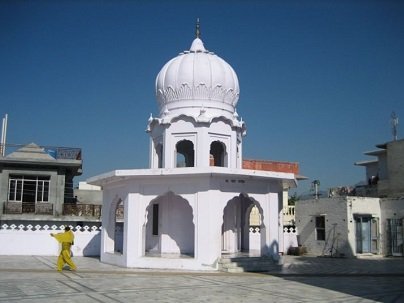Gurudwara Thara Sahib (Anandpur)
Thara Sahib, a half metre high, square platform (five by five metres), paved in marble, stands in the open space in front of Damdama Sahib. It was placed to mark the site where Guru Tegh Bahadur received the group of Kashmiri Pandits who called on him in 1675.
Guru Tegh Bahadur used to live at Bakala and had spent more than seven years (1656-64) in Assam, Bengal and Bihar. Guru Tegh Bahadur had spent some time at Talwandi Sabo and Dhamtan too.
In the middle of April 1665, Guru Tegh Bahadur made a visit to Kiratpur Sahib. When Guru Tegh Bahadur was still at Kiratpur, on 27th April 1665, Raja Deep Chand, the ruler of Bilaspur, died.
The Bilaspur ruler was a very devoted Sikh. On 10th May 1665, Guru Sahib went to Bilaspur to make last prayers for Raja Deep Chand. Guru Sahib stayed there till 13th May.
By this time Rani Champa had come to know that Guru Sahib had decided to move his headquarters to Dhamtan. This made Rani Champa despondent. Rani Champa approached Mata Nanaki (Guru Sahib’s mother) and begged her to ask Guru Sahib not to move far away from Bilaspur State.
Mata Nanaki could not resist helping a sentimental Rani Champa. Mata Ji requested Guru Sahib to fulfil Rani’s desire. When Guru Sahib agreed, Rani Champa offered to donate some land to Guru Sahib so that he might established a new town. Guru Sahib decided to set up new town but refused to accept a donation of the land.
The site of the city of Anandpur Sahib on the lower spurs of Shivalak hills, was purchased by Guru Tegh Bahadur on a payment of rupees five hundred. Guru Tegh Bahadur selected a piece of land in between the villages of Lodipur, Mianpur and Sahota and paid regular price for the same. Rani Champa hesitatingly accepted the price of the land but her joy new no bounds at the thought that Guru Ji had chosen to establish his headquarters near Bilaspur State.
The Site Chosen
The site chosen by Guru Sahib, around the ruins of the ancient village of Makhowal, was very remarkable from a strategic point of view as it was surrounded by the river Satlej on one side as well as having hills and forest surrounding it as well.
Chak Nanaki as the area became known was named after Guru Ji’s mother. It proved to be a peaceful zone for meditation as well as for arts and intellectual activities.
At the time it seemed safe from military interference and disturbances. The Sikhs had experienced Mughal invasions at Amritsar and Kartarpur in 1634 and 1635. Guru Tegh Bahadur Sahib had participated in these battles. Though Kiratpur Sahib had remained safe from Mughal attacks, the possibility always existed because Aurangzeb was sitting on the Delhi throne and he was known for his fanaticism.
Thus, the site selected for new town had a special importance. In 1665, the river Satlej used to flow through the present city of Anandpur Sahib (now it flows near Kiratpur Sahib). Kiratpur Sahib was also a strategic place. It was surrounded by Satlej on one side, river Sirsa on the other side and a chain of hills on the third side.
Similarly, the site of Chak Nanaki was a great choice. It had the protection of Charn Ganga stream on two sides and river Satlej on the third. Towards the hills-side there were thick bushes and trees. Long long ago, it was covered in dense forest filled with herds of wild elephants and other animals. Then, this area was known as Hathaut (literally: abode of elephants).
The area or Chak Nanaki was a peaceful zone. Besides, it was fertile land which could easily yield two crops annually. Hence, the new city was capable of becoming a self-sufficient city-state. Guru Sahib’s selection of the land was highly appreciated by Rani Champa and the Sikhs. The Bilaspur elite were exceptionally happy because the presence of a Sikh city-state on the borders of Bilaspur State and the Mughal territory meant increased safety for Bilaspur and its associate States.












